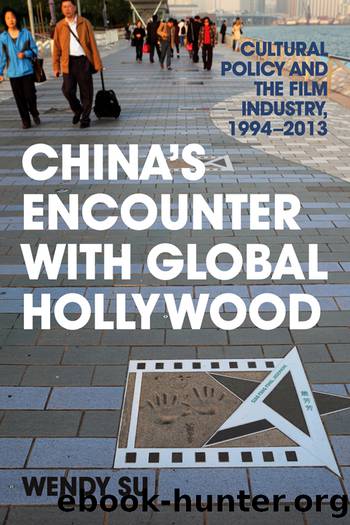China's Encounter with Global Hollywood by Su Wendy;

Author:Su, Wendy;
Language: eng
Format: epub
Publisher: University Press of Kentucky
Published: 2021-08-15T00:00:00+00:00
5
Chinese Martial Arts Cinema in the Twenty-First Century
Hybridity and Soft Power
The resurgence of Chinese martial arts cinema in the first decade of the twenty-first century is a remarkable phenomenon. Neither the genre nor its popularity is new, but its latest resurgence reflects social, political, and global forces with significant implications far beyond the genreâs entertainment value and its previous range of filmic expression. These forces include the Chinese stateâs cultural policy, the demands of film marketization, the inflow and legacy of Hong Kongâs kung fu movies, and the influence of global Hollywood. Intertwined and entangled, they become driving forces and determining factors in the revitalization of this genre in contemporary China.
Historically, Chinese martial arts cinema enjoyed three periods of popularity in the twentieth century: its original emergence in the 1920s; its relocation and revival in Hong Kong from the 1950s to the 1980s, after the Nationalist governmentâs anti-superstition campaign and ban in 1934; and its resurgence in mainland China in the 1980s as part of the new wave of entertaining cinema. Its resurgence after 2000 in mainland China has been described as moving âcloser to its original base in China, signifying a historic closing of the circle.â1 This closing of the circle is the focus of this chapter.
From the Bruce Lee period, when oriental kung fu movies debuted on the international film market, to the global presence of action-packed Hong Kong films featuring Jackie Chan, Chow Yun Fat, and Jet Li in the 1990s, Chinese martial arts cinema exerted an increasing influence. However, not until Ang Leeâs Crouching Tiger, Hidden Dragon won an Oscar and Zhang Yimouâs Hero became both a national and an international box office hit did this genre and its global impact begin to attract intense scholarly interest. Within the fields of international communication, international cultural studies, and film studies, Chinese martial arts cinema has become a popular research topic. A number of studies have investigated the resurgence of the genre and its implications in an era of globalization. Some research has mapped the trajectory of the history of Chinese martial arts cinema.1 Other studies are devoted to the genreâs aesthetic connotations and philosophical implications. Chinese martial arts cinema has been posited as a negotiation between science and fate and between nationalism and modernity,1 as an embrace of cultural nationalism and a mode of transnationalism,1 and as an expression of antiorder resistance and a representation of identity crises.1 Researchers have used Hero as a case study, discussing its discourses and themes, philosophical essence, and aesthetic significance.1 Some have taken the perspective of political economy to analyze the âglobal-local allianceâ in the successful production and distribution of a Chinese âglobal blockbuster.â1 Others have provided pungent criticism of the âspiritâ and âstructureâ of Hero and concluded that the film reflects both the fascist spirit and the post-9/11 imperial logic.1 Researchers thus bring up the issue of global-local dialectic and raise this question: âIn various accounts of âglocalization,â âhybridizationâ and âtransculturation,â which side is prevailing?â1 They have suggested that Hero represents a triumph of globalization.
Download
This site does not store any files on its server. We only index and link to content provided by other sites. Please contact the content providers to delete copyright contents if any and email us, we'll remove relevant links or contents immediately.
The Vikings: Conquering England, France, and Ireland by Wernick Robert(79212)
Ali Pasha, Lion of Ioannina by Eugenia Russell & Eugenia Russell(39936)
The Vikings: Discoverers of a New World by Wernick Robert(36828)
The Conquerors (The Winning of America Series Book 3) by Eckert Allan W(36714)
Cecilia; Or, Memoirs of an Heiress — Volume 1 by Fanny Burney(32086)
Cecilia; Or, Memoirs of an Heiress — Volume 3 by Fanny Burney(31477)
Cecilia; Or, Memoirs of an Heiress — Volume 2 by Fanny Burney(31432)
Empire of the Sikhs by Patwant Singh(22778)
Hans Sturm: A Soldier's Odyssey on the Eastern Front by Gordon Williamson(18338)
The Secret History by Donna Tartt(18251)
Cat's cradle by Kurt Vonnegut(14799)
Sapiens: A Brief History of Humankind by Yuval Noah Harari(14004)
Pimp by Iceberg Slim(13819)
Talking to Strangers by Malcolm Gladwell(12910)
Norse Mythology by Gaiman Neil(12875)
Leonardo da Vinci by Walter Isaacson(12829)
Underground: A Human History of the Worlds Beneath Our Feet by Will Hunt(11855)
4 3 2 1: A Novel by Paul Auster(11831)
The Radium Girls by Kate Moore(11644)
